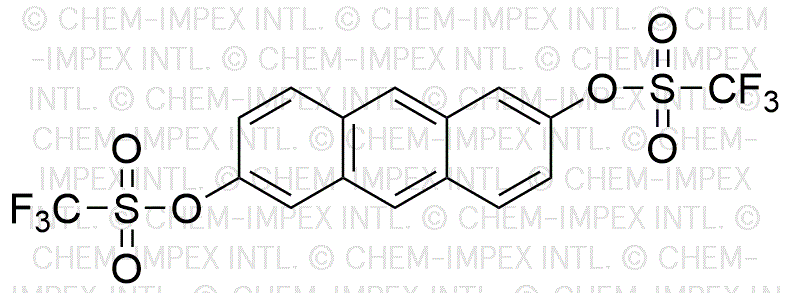Anthracene-2,6-diyl bis(trifluoromethanesulfonate) is widely utilized in research focused on:
- Organic Electronics: This compound serves as a key material in the development of organic light-emitting diodes (OLEDs) and organic photovoltaic cells, enhancing efficiency and performance.
- Chemical Synthesis: It acts as a versatile reagent in organic synthesis, facilitating the formation of complex molecules through its reactive trifluoromethanesulfonate groups.
- Fluorinated Materials: The compound is used in creating fluorinated polymers, which exhibit superior thermal stability and chemical resistance, making them ideal for high-performance applications.
- Research in Photochemistry: It is employed in studies investigating photochemical reactions, helping researchers understand light-induced processes in organic compounds.
- Analytical Chemistry: This chemical is utilized as a derivatizing agent in mass spectrometry, improving the detection and analysis of various organic compounds.
General Information
Properties
Safety and Regulations
Applications
Anthracene-2,6-diyl bis(trifluoromethanesulfonate) is widely utilized in research focused on:
- Organic Electronics: This compound serves as a key material in the development of organic light-emitting diodes (OLEDs) and organic photovoltaic cells, enhancing efficiency and performance.
- Chemical Synthesis: It acts as a versatile reagent in organic synthesis, facilitating the formation of complex molecules through its reactive trifluoromethanesulfonate groups.
- Fluorinated Materials: The compound is used in creating fluorinated polymers, which exhibit superior thermal stability and chemical resistance, making them ideal for high-performance applications.
- Research in Photochemistry: It is employed in studies investigating photochemical reactions, helping researchers understand light-induced processes in organic compounds.
- Analytical Chemistry: This chemical is utilized as a derivatizing agent in mass spectrometry, improving the detection and analysis of various organic compounds.
Documents
Safety Data Sheets (SDS)
The SDS provides comprehensive safety information on handling, storage, and disposal of the product.
Product Specification (PS)
The PS provides a comprehensive breakdown of the product’s properties, including chemical composition, physical state, purity, and storage requirements. It also details acceptable quality ranges and the product's intended applications.
Certificates of Analysis (COA)
Search for Certificates of Analysis (COA) by entering the products Lot Number. Lot and Batch Numbers can be found on a product’s label following the words ‘Lot’ or ‘Batch’.
*Catalog Number
*Lot Number
Certificates Of Origin (COO)
This COO confirms the country where the product was manufactured, and also details the materials and components used in it and whether it is derived from natural, synthetic, or other specific sources. This certificate may be required for customs, trade, and regulatory compliance.
*Catalog Number
*Lot Number
Safety Data Sheets (SDS)
The SDS provides comprehensive safety information on handling, storage, and disposal of the product.
DownloadProduct Specification (PS)
The PS provides a comprehensive breakdown of the product’s properties, including chemical composition, physical state, purity, and storage requirements. It also details acceptable quality ranges and the product's intended applications.
DownloadCertificates of Analysis (COA)
Search for Certificates of Analysis (COA) by entering the products Lot Number. Lot and Batch Numbers can be found on a product’s label following the words ‘Lot’ or ‘Batch’.
*Catalog Number
*Lot Number
Certificates Of Origin (COO)
This COO confirms the country where the product was manufactured, and also details the materials and components used in it and whether it is derived from natural, synthetic, or other specific sources. This certificate may be required for customs, trade, and regulatory compliance.

